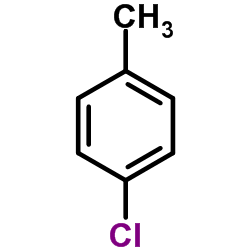4-Chlorotoluene

4-Chlorotoluene structure
|
Common Name | 4-Chlorotoluene | ||
|---|---|---|---|---|
| CAS Number | 106-43-4 | Molecular Weight | 126.584 | |
| Density | 1.1±0.1 g/cm3 | Boiling Point | 162 ºC | |
| Molecular Formula | C7H7Cl | Melting Point | 6-8 °C(lit.) | |
| MSDS | Chinese USA | Flash Point | 49 ºC | |
| Symbol |



GHS02, GHS07, GHS09 |
Signal Word | Warning | |
|
QSPR modeling of octanol/water partition coefficient for vitamins by optimal descriptors calculated with SMILES.
Eur. J. Med. Chem. 43 , 714-40, (2008) Simplified molecular input line entry system (SMILES) has been utilized in constructing quantitative structure-property relationships (QSPR) for octanol/water partition coefficient of vitamins and organic compounds of different classes by optimal descriptors.... |
|
|
Optimizations of packed sorbent and inlet temperature for large volume-direct aqueous injection-gas chromatography to determine high boiling volatile organic compounds in water.
J. Chromatogr. A. 1356 , 221-9, (2014) For the expanded application area, fast trace analysis of certain high boiling point (i.e., 150-250 °C) volatile organic compounds (HVOCs) in water, a large volume-direct aqueous injection-gas chromatography (LV-DAI-GC) method was optimized for the following ... |
|
|
Mechanism-Based Post-Translational Modification and Inactivation in Terpene Synthases.
ACS Chem. Biol. 10 , 2501-11, (2015) Terpenes are ubiquitous natural chemicals with diverse biological functions spanning all three domains of life. In specialized metabolism, the active sites of terpene synthases (TPSs) evolve in shape and reactivity to direct the biosynthesis of a myriad of ch... |
|
|
Effects of p-chlorotoluene (PCT) on rat lung and liver benzo[a]pyrene metabolism and microsomal membrane structure and function.
J. Toxicol. Environ. Health A 50(2) , 159-72, (1997) Treatment of rats with p-chlorotoluene (PCT, 1 g/kg, ip) resulted in peak PCT blood and lung concentrations at 4 h, which declined to very low levels at 12 h. The concentration of PCT in the liver attained its highest value at 1 h and also declined to low lev... |
|
|
Molecular structure and vibrational spectra of o-chlorotoluene, m-chlorotoluene, and p-chlorotoluene by ab initio HF and DFT calculations.
Spectrochim. Acta. A. Mol. Biomol. Spectrosc. 78(3) , 1126-32, (2011) In this work, experimental and theoretical study on the molecular structure and the vibrational spectra of o-chlorotoluene (OCT), m-chlorotoluene (MCT) and p-chlorotoluene (PCT) are presented. The vibrational frequencies of these compounds were obtained theor... |
|
|
Reaction dynamics of the 4-methylphenyl radical (p-tolyl) with 1,2-butadiene (1-methylallene): are methyl groups purely spectators?
J. Phys. Chem. A 118(32) , 6181-90, (2014) The reactions of the 4-tolyl radical (C6H4CH3) and of the D7-4-tolyl radical (C6D4CD3) with 1,2-butadiene (C4H6) have been probed in crossed molecular beams under single collision conditions at a collision energy of about 54 kJ mol(-1) and studied theoretical... |
|
|
[Establishment of the maximum permissible concentrations of o- nd p-chlorotoluenes in reservoir water].
Gig. Sanit. (2) , 67-8, (1981)
|
|
|
[Hygienic standardization of p-chlorobenzylchloride in reservoir water].
Gig. Sanit. (5) , 13-4, (1990)
|
|
|
Multireference calculations of the fluorescence, phosphorescence and photodissociation of p-chlorotoluene.
Phys. Chem. Chem. Phys. 7(23) , 3938-42, (2005) Equilibrium geometries and vibrational frequencies of the ground and some excited states of p-chlorotoluene were calculated by the complete active space self-consistent field (CASSCF) method. Multi-reference CASSCF second order perturbation theory (MSCASPT2) ... |
|
|
Insights into the origin of high activity and stability of catalysts derived from bulky, electron-rich monophosphinobiaryl ligands in the Pd-catalyzed C-N bond formation.
J. Am. Chem. Soc. 125(46) , 13978-80, (2003) A comparative kinetic examination of catalyst systems based on several monophosphinobiaryl ligands is reported. The bulk of the phosphine ligand controls the catalytic activity and the rate of catalyst activation with the catalyst based on 2-dicyclohexylphosp... |